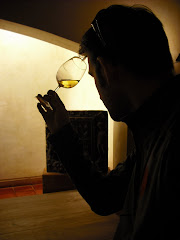1. You will need
- A food grade plastic bucket (at least 30 L capacity) and lid
- A long plastic spoon or paddle, to stir with
- 5 gram yeast sachet (provided in most kits but most can be bought for a dollar if not provided)
- Sanitizer (potassium metabisulfite powder, or food-grade sanitizing powder product such as chloroclean)
- Hydrometer and test jar (see Fig. 1)
- A wine thief
- Measuring cups
- Pectic enzyme
- Yeast nutrient broth powder
- Plastic or glass gallon jug
2. “Cleanliness is next to Godliness”. That’s right, sanitize everything! Organisms of all kinds, including bacteria, moulds, and wild yeast are everywhere and like to coat your equipment in their mucky essence. They would just love to have a bite of your expensive, sugary juice. They will eat their fair share and give you nothing back but stinky odours and most likely turn your batch into vinegar or worse. Get rid of them by washing and soaking your equipment with the sulfite powder (a tablespoon per liter of cool water will be strong enough, a teaspoon of citric acid helps too – try not to inhale the vapours) or alternative product (follow the manufacturer’s directions for dissolving in water).
From a microbiologist's perspective, like my own, sulfites greatly inhibit the growth of these critters so that they won’t be a harm. Rinse everything in copious amounts of clean water and do not let your clean equipment touch uncleanly surfaces. Wash your hands as well, with hand soap.
NOTE: It is best not to use dish soap as it leaves a filmy residue that will make your wine taste just like the detergent you use (“Hey there, care to try my “Sapon Sauvignon 2006?” – yuck!). Do not use liquid bleach (e.g. Javex) as it too can leave a film and impart off flavours (or even poison your guests!). I often use a product called Chloroclean for big washes. It is a chlorinated product that is safe for food processing. It rinses clean from plastic and glass surfaces. Again, rinse everything well.
3. Pour the juice into the large plastic bucket (easy enough). If you bought a kit that is a concentrate, reconstitute the mix by stirring in the rest of the volume using lukewarm water. Example, if you have a kit that has a concentrate volume of 15 L and the kit makes 23 L, add 8 L of water).
4. Rehydrate the yeast culture: In 50 mL (1/4 cup) of warm water (Ideally, 40°C/104°F. I don’t think you would like to wake up from your slumber to an ice cold shower, would you?). Let the yeast sit for 15 minutes and then gently stir.
OPTIONAL: The yeast nutrients mentioned in the list refer to a mixture of carbohydrates, fats, and proteins that supplement yeast growth. Dissolve in warm water according to the manufacturer’s instructions and then add the yeast for rehydration.
5. Wait until the juice is approximately the same temperature, as the yeast solution (i.e. within 10-15 degrees of each other; the juice will warm up in the room while the yeast solution will begin to cool down).6. Pitch the yeast into the juice and stir very well.
*ProStar Tips*:
Remember your gallon jug? Place the rehydrated yeast slurry into the jug and then stir in 2 cups of juice every 30 minutes until the jug is full (or until you get bored) and then stir the mix into the rest of the juice. What this does is help the yeast to “acclimatize” to the new “juicy” environment. They will get used to the temperature changes, acidity, and begin to digest the juices ingredients (especially sugars). Acclimatization gives the yeast population a head-start and gives excellent, no-hassle, results until the fermentation ends. Picture it like you are ‘training’ the yeast cells to do their job exceptionally well before you give them a large task. Would your boss give you responsibility over the company’s biggest jobs right away? Not likely, but they would be glad to have you ‘work your way up’ first. This mixture is called the “yeast starter” and is a technique used by even the most famous winemakers.
Pectic enzyme? This enzyme breaks down pectin (a complex of sugars that are found in jams and jellies). Pectin causes juices (and newly made wines) to haze up and prevent clearing.
7. Remove some juice with your wine thief and place into your hydrometer and test jar. Float the hydrometer in the jar and read off the point at which the surface of the juice meets the meter. Record this value because we’ll use it later! Generally it should read between 1.100 and 1.070.
Believe it or not, you have just started your first ‘primary fermentation’. It is best practice to keep monitoring the specific gravity of your fermenting juice daily. In about 5-7 days the S.G. should reach close to 1.010.

Fig. 1 A hydrometer. See the gradations and numbers along the stem. Simply drop the hydrometer in the juice and it will float or sink depending on how dense the juice is. More sugar causes the meter to rise higher. As the juice ferments, it will sink into the red zone shown here which corresponds to a specific gravity of 1.000.


No comments:
Post a Comment